What is a Business Model Canvas (BMC)?
What is a Business Model Canvas (BMC)? : Do you always have good business ideas but can’t explain them to others? A Business Model Canvas is a strategic management tool that helps you quickly and easily define a business idea or concept.
This single-page document consists of the essential elements of a business or product and provides a coherent structure for an idea.
The right side of the canvas focuses on the customer (external factors), while the left focuses on the business (internal factors).
Both these external and internal factors converge around the value proposition, which is the value exchange between your business and your customer or customers.
Why use a Business Model Canvas?
- It is a great way to quickly understand the requirements for implementing an idea.
- It helps us understand the business, connecting the idea, and how to turn it into a business.
- It explores the types of decisions a customer makes about using your system.
- It will give everyone a clear understanding of the potential business idea.
How to Use the Business Canvas
Value Proposition:
A value proposition is essential to any business or product.
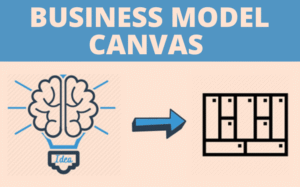
This concept forms the basis of the value exchange between your business and its customer(s).
Generally, customers pay for the value exchanged when a problem is solved or your business alleviates a pain.
Good questions to ask yourself when defining your business or product:
- What problem am I trying to solve?
- Why would someone want this problem solved?
- What is the primary driver of this problem?
Tips:
A good way to map out the user or customer segments in the business canvas is to look at the customer segments. Based on Maslow’s Hierarchy of Needs, identify where your product or service solves a customer problem.
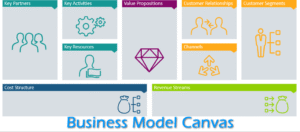
If you sell your product or service to another business, you are their key partner in creating value for their customers.
You should identify the company’s goals for the customer segments and the place of your business, product, or service in the value chain.
Customer Segments
Customer segmentation is dividing a customer base into groups of people who are similar in specific ways, such as age, gender, interests, and spending habits.
Things to consider when determining customer segments include:
- Whose problem are we solving?
- Who would value my value proposition?
- Are there other businesses?
- If so, what are the characteristics of those businesses?
- Or are they other people?
- Is my value proposition appealing to men, women, or both?
- Is it appealing to 20-30-year-olds or teenagers?
- What are the characteristics of people who are looking for my value proposition?
Another thing to measure and understand is the size of your market and the number of people in your customer segment. This will give you a good understanding of your market from a micro and macro perspective.
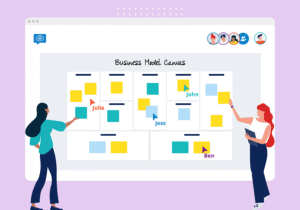
A great way to understand your customer is to create personas for each customer segment.
Customer Relationship
Okay, so we know our value proposition and have developed personas to understand better our customer segments or customers, but what kind of relationship do we have with our customers?
Customer relationship is defined as how a business interacts with its customers.
Do you meet them in person or on the phone? If your business is primarily conducted online, will your customer relationship also be online?
Some examples of these relationships include:
- In-person (one-to-one)
- Third-party contractors
- Online
- Events (one-to-many)
- Telephone
A helpful step in this regard is creating a user journey map for customers interacting with your business.

This method identifies the points of interaction between you and the customer and the modes of communication you use to communicate with customers.
This process also helps you define your operations as a business and identify marketing automation opportunities.
What is a Business Model Canvas (BMC)?
Channels
A channel is how customers interact with your business and become part of your sales cycle.
These channels are collectively known as your business’s marketing plan.
Good questions to ask yourself when identifying customer access channels include:
- How do I communicate my value proposition to my customers?
- Where are our customers?
- Are they on social media?
- Do they have their car and listen to the radio?
- Are they attending an event or conference?
- Are they watching TV at 7 pm on Friday nights?

Examples of Channels:
- Social Media
- Public Speaking
- Email Marketing
- Networking
- SEM (Search Engine Marketing)
- SEO (Search Engine Optimization)
- Marketing Engineering
- Viral Marketing
- Blog Targeting
- Commission Sales and Advertising
- Affiliates
- Existing Platforms
- Public Relations
- Unconventional PR
- Social Advertising
- Trade Shows
- Content Marketing
- Community Building
- Offline Advertising (Billboards, TV, Radio)
Knowing how to reach customers is crucial for your business.
What is a Business Model Canvas (BMC)?
Key Activities
Key business or product activities are your business’s actions to create value for its customers.
Questions to Ask:
- What activities does the business take to create value for its customers?
- What resources are used?
- Time?
- Experience and expertise?
- Product distribution?
- Technical development?
- Strategy?
- Suggested resources (human/physical)?
- What actions did you or your employees take to achieve the value exchange?
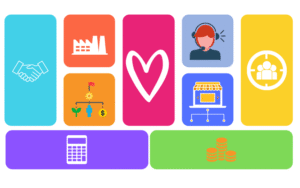
Examples:
- Consulting
- Design
- Web development
- Cooking
- Driving
- Shoveling
Critical resources
Next, consider the practical resources needed to achieve the key business activities (actions).
Key means the resources that your business needs to do business.
These resources are what is needed to do your business activity or activities:
- Office space
- Computers
- Hosting
- People (employees)
- Internet connection
- Cars
- Bicycles
- Ovens
- Electricity
- Car parts
Key partners
Key partners are a list of other companies, suppliers, or external partners you may need to achieve your key activities and create value for the customer.

This area is ” If my business can’t deliver on its value proposition alone, who should I rely on to deliver?”
An example is, ” If I want to sell groceries to customers, I might need a local baker to deliver fresh bread to my store.”””
They are a key partner in delivering the value my business promises to customers.
What is a Business Model Canvas (BMC)?
Cost Structures
Your business’s cost structure is the monetary cost of running a business.
- How much does it cost to achieve my business’s key activities?
- How much do key resources and partnerships cost?
- How much does achieving my value proposition for my customers or users cost?
- Are there any additional costs to starting a business?
- How much does it cost to get a license?
- How much does insurance cost?
- What are my business expenses?
- Also, what is the monetary value of the time you’ve invested?
- How much does it cost to hire yourself?
- What is the opportunity cost of starting your business?
Revenue Streams
A revenue stream is how your business turns a value proposition or solution to a customer’s problem into a financial benefit.
Also, price your business based on the pain of buying versus the pain of solving a problem for your customer.
But how do you make money?
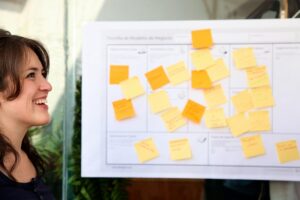
Here are the different revenue models:
- Pay-per-view
- Fee-for-service
- Flat-rate
- Subscription
- Dividends
- Referral feeds
- Freemium
- Dividends
Tools used to draw a business canvas
- https://canvanizer.com
- Whiteboard
- Template paper
- Google Slides
Finally
The technology and art of design are here to help you turn your business ideas and concepts into a visual form that is clear and understandable to everyone. Business Canvas is great for reaching a common understanding in team activities. Also, if you are not a good visual thinker, use this tool to communicate between internal and external stakeholders of your business. If you have ever used Business Canvas, please share your thoughts.
Source
https://medium.com/seed-digital/how-to-business-model-canvas-explained-ad3676b6fe4a